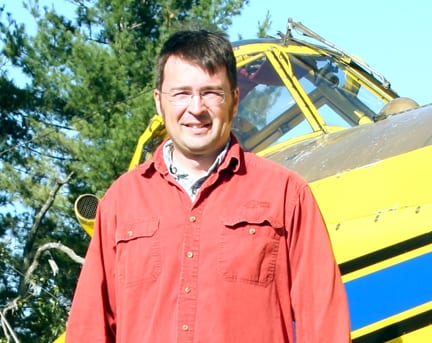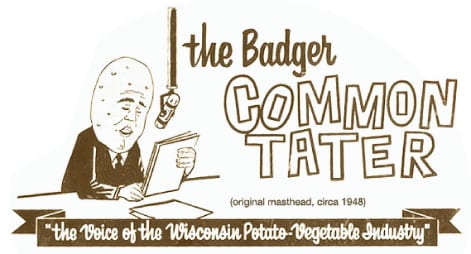
Originally, aerial applicators were known as ‘crop dusters’ because they worked with powdered forms of chemicals and were literally dusting fields. That term is no longer appropriate since aerial applicators now deliver liquid products or dry granular products and even cover crops seed to control pests and diseases and provide nutrients for American agriculture.
Today’s professional aerial applicator service firms like Reabe Spraying Service Inc, consist of highly skilled pilots operating technically advanced aircraft outfitted with global positioning systems, sophisticated dispersal systems and calibration software for precise application.
Committed to their customers and the communities in which they operate, the owners of these firms and their employees are ever mindful of the environment surrounding the fields where they work since that is also, where they, their families, friends and neighbors reside.
Currently, aerial applicators handle delivery of up to one fourth of crop protection products in American agriculture, primarily because aircraft can cover more area faster and more effectively, without disturbing the soil or the growing crops. This is vitally important because some pests and disease can cause serious crop damage in a matter of a day or two.

That is why for our crop protection issue, we chose to interview Roy Reabe’s grandson, Damon Reabe, now President of Reabe Spraying Service Inc, which has grown into one of the largest aerial application services in the Midwest.
Please share with us some anecdotal information you remember about your grandfather, Roy Reabe, who laid the groundwork for the Reabe companies.
Grandpa’s crop dusting start is a pretty funny story. After returning from service in late 1945, he opened an airport in southern Wisconsin and started a flight school.
His ‘market research’ for selecting a location was quite simple. He searched a map of southern Wisconsin and found the largest city not already served by an airport, which happened to be Waupun.
At first, business was slow. Grandpa did not understand why there were not more people in a city the size of Waupun interested in learning to fly, especially with the Government GI Bill paying for training.
Then, he discovered that Waupun’s census included Waupun’s maximum-security prison inmates. He realized that if he wanted to make a living in aviation, he needed to change his plan.
He learned that area pea canners were contracting with out-of-state crop dusters to control aphids and decided to pursue a crop dusting business. He contacted area canners who contracted with him for the 1950 growing season. With this commitment, he purchased a J-3 Cub, outfitted it with a wooden hopper and taught himself to dust.
Without Grandpa’s poor market research, Reabe Spraying Service may never have become a reality.
How did you first get involved with the Reabe companies and then progress in your career into your present position of President of Reabe Spraying Inc.

I started at the age of ten doing chores like mowing and cleaning. When Grandpa retired from the aerial application business, he began farming full time, primarily raising processing vegetables along with some alfalfa on his 500-acre farm. I worked for him on the farm in exchange for flying lessons starting at 12 years old.
Growing up at the airport, I knew at a very young age I wanted to fly for a living. I pursued a career as a professional pilot and flew corporate jets throughout North and South America as well as Europe for 15 years.
In 1997, I landed a job in Appleton and moved back home to Waupun. That summer my Dad, Tom, trained me to spray and until 2008, I spent my spare time helping Reabe Spraying Service as an aerial applicator.
As my corporate pilot career developed, I shifted into non-flying, management roles overseeing approximately 300 pilots for the largest corporate aircraft management company in the U.S., which prepared me for my present role at Reabe Spraying Service.
In 2009, my Dad decided to retire. However, he still plays an important role and works daily for the company. At that time, my Dad and three uncles offered me the job as President of Reabe Spraying Service, which I now manage, while also flying for the company.
What changes and advances have you seen from your grandfather’s earlier days until now?
The most significant advances in our industry are in the products we apply. In my Grandfather’s day, crop dusters used sulfur in dust form. Sulfur is toxic to plant pathogens and many insect species and under certain conditions can kill vegetation. It was applied at high use rates but yielded poor results. Ironically, sulfur is still used in organic pest control systems.
When the first synthetic products came on the scene, they were more effective in controlling pests, but were often toxic to the handlers and the environment.
Today, formulations are handler and environment friendly with active ingredients, in some cases, that are EPA registered for home, lawn and commercial kitchen use, yet they are much more effective at controlling the target pest and less product is required per acre.
Application equipment has also improved. Aircraft are faster, larger, more reliable and productive so fewer people can accomplish the work in a shorter time.
Dispersal systems are more sophisticated. The nozzles themselves create a consistent droplet spectrum and the booms are modified to improve uniformity and accuracy. Today, the rate variation across our swath is 7% compared to the 25% considered acceptable during my Grandfather’s day.


Our technology has grown dramatically as well. Our aircraft are all equipped with GPS guidance systems helping further reduce application variation. We also use ArcMap geographic information system (GIS) mapping software that allows us to digitize unusual obstructions that may pose a risk to pilots, notify neighbors that request a notice prior to application and provides other tools that ensure pinpoint accurate application.
What safety challenges do you face not just for yourself and your employees, but also in relationship to surrounding fields, farm workers and the public and how do you promote a culture of safety?
The flying we do involves inherent risk due to the proximity in which we operate relative to obstructions. Our company does everything humanly possible to mitigate this risk.
Regarding the safety of the pilots, our approach is simple. We hire and retain pilots with a large amount of aerial application experience whom also have an exemplary safety record. However, we will train individuals and have one aerial applicator, who started with us as a mixer/loader. His training began in 2009 and he just recently transitioned into piloting one of our turbine-powered aircraft.
Safety is everything regarding surrounding fields, farm workers and the public. As a company, we pursue perfection and our greatest emphasis involves reducing drift. Following are just a few of our safety steps:
- Only use nozzles wind tunnel tested at the USDA-Agricultural Research Station to produce the least amount of small droplets.
- Developed and installed a spray boom system in all of our airplanes allowing pilots to change the overall droplet size in flight. Pilots can then disperse larger droplets near sensitive field edges and smaller droplets in the remainder of the field. Currently, only two other aircraft in the United States are equipped with this technology.
- Incorporate inflight selector valves in the spray boom to reduce the amount of product lifted by the wingtip vortex, thereby further reducing offsite drift.
- Run our aircraft through pattern testing clinics where University researchers analyze our spray pattern for uniformity and droplet size and test the efficacy of our droplet selector and boom selector valves. Additionally, we test for the optimum speed at which we should release product to maintain swath and droplet uniformity, further reducing spray drift.
- Incorporate ArcMap GIS software into our business allowing us to overlay endless concerns such as locations of organic crops, beehives and neighbors requesting notification prior to spraying, on top of continually updated aerial imagery.
- Enrolled in Driftwatch, a registry tool that helps pesticide applicators and specialty crop growers communicate more effectively to prevent and manage drift effects on sensitive/protected areas and promote good stewardship activities.
- Help growers select the least toxic product to control any given pest.
- Developed a customer notification system that provides regulatory and compliance information required by law in a timely, condensed and easy to reference format.

Outsource services such as aerial applications can often become ‘rescue applications” or last minute scheduling. What problems occur when this happens and what would you suggest to growers to help avoid this situation?
Timely application is extremely important in pest control, particularly for potatoes and other vegetables. Our customers provide us with their crop maps early in the season, often prior to planting. We then advance plan and only commit to spraying 50% of the capacity of our company. During extended rain or wind that keep our aircraft parked for a day or two, we still catch up in a very short time.
When areas have long periods of rain or soil conditions are not suitable for ground equipment, we do our very best to fulfill these ‘rescue applications’ but must first complete the work to which we previously committed.
My only advice to growers is to maintain a relationship with an aerial applicator of your choice and consider offering them regular work. By maintaining a business relationship with an applicator, ‘rescue applications’ to the whole farm can be prioritized, ensuring timely service in a time of extreme weather and need.
What do you feel are the most important benefits a grower receives by utilizing the services of committed, trained professional aerial service applicator firms such as yours and what parameters should a grower consider in selecting an aerial services firm?

I think the single biggest benefit aerial application offers is timeliness of application. Growers and University researchers all agree, in order to control pests with the least amount of pesticide, you must perform applications in a timely and thorough manner. Aerial application can accomplish that even over sizable acreages spread out over large geographical areas.
When selecting an aerial application firm, I suggest questioning the following aspects:
- How experienced is the aerial application company in aerial applications of vegetable crops, particularly potatoes?
- Does the firm have the facilities and enough equipment needed to get the job done in a timely and thoroughly manner?
- Do other growers in the area have a longstanding relationship with the firm?
Are crop protection products safe?
Statistics from a study released by the Agricultural Health Study help illustrate how safe crop protection products are to humans.
The study is a collaborative effort involving investigators from National Cancer Institute, National Institute of Environmental Health Sciences, Environmental Protection Agency and National Institute for Occupational Safety and Health. The study analyzed all of the deaths occurring from 1993 to 2007 among 89,656 pesticide applicators and spouses.
According to this study, pesticide handler mortality rates are 46% less than the general population and mortality rates from all cancers combined are 40% less than the general population. A similar study was conducted in the United Kingdom and the outcome was the same.
If crop protection products were harmful to humans, pesticide handlers would experience much higher mortality rates due to the intense exposure we have to pesticides relative to the general population.
Some people ask about the safety of pesticides to our environment. Not only do I feel they are safe for the environment, but strongly believe they benefit the environment given the current demand for food, fiber and fuel. They help increase production on any given area of land, lessening the need to convert conservation land or forested areas, to agricultural use.
I think Dr. Patrick Moore, who played a significant role in Greenpeace Canada for several years, said it best “In fact, it’s better pesticide science that has allowed North America to triple its food production while maintaining the same amount of forest cover as existed a century ago.”

Why do we need crop protection products to grow food and other crops?
The list of reasons why we need crop protection products is as long as the list of pests that jeopardize crops.
Each spring, I share the following agricultural data from Wisconsin Blue Book with the Ripon 7th graders on behalf of the Ripon FFA.
The amount of land in agricultural production in 2009 was 2.7 million acres less than in 1988 yet crop production increased as follows: four times more corn, seven times more soybeans, two times more green beans and one and a half times more peas.
This helps students understand the benefits of GMO’s, synthetic pesticides and fertilizers in that there is an increase in production while utilizing less land.
During that same period, the State of Wisconsin purchased 500,000 acres of farmland (781 square miles) and converted it to conservation land, open to the public. Without pesticides, this achievement would not be possible.
Explaining the need for pesticides is one of the most difficult challenges agriculture faces. The best way to overcome this challenge is for all of us to educate the public and our children as to the benefits of pesticides and the ramifications of limiting or losing access to these tools.

Currently, those involved in agriculture are only 2% of society and that percentage is most likely going to continue shrinking. The 2% works very hard to produce the food, fiber and fuel our country and other countries need and it is very difficult to find the time needed to educate the other 98% of the nation. That is why we also need to lobby government (USDA, EPA and State) and other interests to help educate society towards the benefits of crop protection products.


